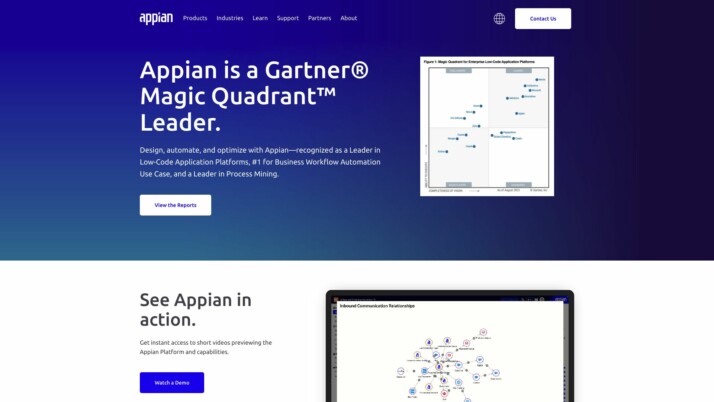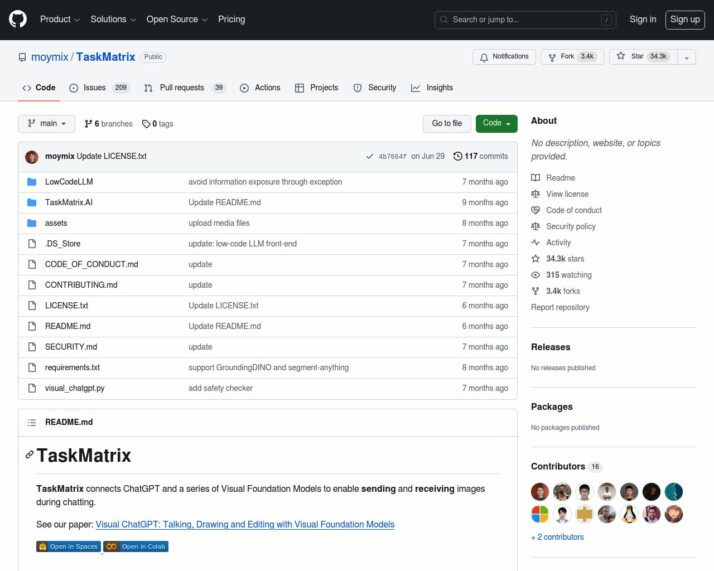Appian vs. TaskMatrix: Comparing AI Integration Approaches
Artificial Intelligence (AI) transforms businesses, but choosing the right platform can be challenging. Our comparison of Appian vs. TaskMatrix, and SmythOS reveals key differences in AI integration, automation, and user accessibility. Appian offers low-code solutions for business processes, while TaskMatrix connects foundation models with specialized APIs. SmythOS combines these strengths, providing intuitive tools and advanced AI capabilities.
Whether you’re a developer seeking powerful integrations, a business leader focused on scalability, or a non-technical user looking for accessible AI solutions, this review will help you navigate the landscape of AI platforms and find the best fit for your needs.
Appian Overview
Appian transforms complex business processes into streamlined, AI-powered workflows. The low-code platform empowers organizations to rapidly build and deploy intelligent applications without extensive coding expertise. Appian’s AI capabilities enhance automation, decision-making, and data processing across industries like financial services, healthcare, and government.


At its core, Appian offers an AI Skill Designer that enables users to create custom AI models using intuitive visual tools. These models tackle tasks like document classification, data extraction, and email routing. Appian’s commitment to data privacy ensures AI operations occur within secure, company-controlled environments — a critical factor for enterprises handling sensitive information.
Appian excels in combining AI with robust process automation capabilities. The platform seamlessly integrates AI-driven insights into existing workflows, enhancing efficiency and accuracy. Features like the Enterprise Copilot provide instant access to curated business knowledge, accelerating decision-making. Appian’s pre-built AI components for common use cases speed up development and deployment.
Appian transforms complex business processes into streamlined, AI-powered workflows. The low-code platform empowers organizations to rapidly build and deploy intelligent applications without extensive coding expertise.
While Appian offers powerful AI integration, it may not be ideal for organizations seeking highly specialized or cutting-edge AI research applications. The platform focuses on practical business AI rather than pushing the boundaries of AI capabilities. Additionally, users invested heavily in other tech stacks may face integration challenges.
Appian’s position in the market emphasizes accessible AI for business process improvement. The platform bridges the gap between complex AI technologies and real-world enterprise needs, making it a strong contender for organizations looking to infuse AI into their operations without requiring a team of AI specialists.
TaskMatrix Overview
TaskMatrix.AI represents Microsoft’s ambitious foray into advanced AI ecosystems. This open-source platform enhances general-purpose foundation models like GPT-4 by seamlessly integrating them with specialized models through APIs. TaskMatrix functions as a sophisticated project manager, bridging diverse AI models to execute a wide array of tasks efficiently.


At its core, TaskMatrix connects foundation models with specialized APIs, enabling complex task execution in both digital and physical realms. The system interprets user instructions, generates executable action codes, and performs tasks using the most appropriate APIs. TaskMatrix’s architecture includes a vast API repository, an intelligent API selector, and an action executor, forming a comprehensive AI solution.
TaskMatrix connects foundation models with specialized APIs, enabling complex task execution in both digital and physical realms.
TaskMatrix stands out for its ability to perform both digital and physical tasks, its lifelong learning capabilities, and its provision of interpretable responses. The platform’s unique selling point lies in its versatility—connecting powerful foundation models with millions of APIs to tackle an extensive range of tasks across different domains.
Developers can leverage TaskMatrix to create and deploy custom AI models, access pretrained models and API connectors for specific tasks, and utilize an extensive resource library for AI solution development. This modular design and comprehensive API ecosystem make TaskMatrix a versatile tool for businesses looking to integrate advanced AI into their operations.
While TaskMatrix offers impressive capabilities, it’s worth noting that the platform may present a steeper learning curve for non-technical users compared to some alternatives. Additionally, as an open-source project, the level of direct support and documentation may vary, potentially requiring users to rely more heavily on community resources and self-guided learning.
Feature Comparison
Appian and TaskMatrix offer distinct approaches to AI integration and automation, each with its own strengths and limitations. Appian excels in low-code AI integration for business process improvement, while TaskMatrix provides a more open and flexible ecosystem for connecting foundation models with specialized APIs.
Appian’s visual builder and no-code options make it accessible for users with limited technical expertise. Its AI Skill Designer allows rapid creation of custom AI models for tasks like document classification and data extraction. However, Appian lacks some advanced AI capabilities present in TaskMatrix, such as autonomous agents, multi-agent collaboration, and integration with foundation models.
TaskMatrix offers superior flexibility in connecting powerful foundation models like GPT-4 with millions of specialized APIs. This enables it to tackle a broader range of tasks across digital and physical domains. TaskMatrix’s open-source nature and modular design provide greater customization options for developers, though this may present a steeper learning curve compared to Appian’s more streamlined approach.
In terms of security, both platforms prioritize data privacy and encryption. Appian emphasizes keeping AI operations within secure, company-controlled environments, which may be particularly appealing for enterprises handling sensitive information. TaskMatrix’s approach to security is less explicitly defined in the available information.
We have engineered SmythOS to combine the strengths of both platforms while addressing their limitations. Our platform offers an intuitive visual builder and no-code options like Appian, but also provides the flexibility and advanced AI capabilities of TaskMatrix. SmythOS supports autonomous agents, multi-agent collaboration, and seamless integration with various foundation models and APIs. Additionally, we’ve implemented robust security measures and a comprehensive feature set that includes memory and context management, multimodal capabilities, and advanced deployment options, positioning SmythOS as a versatile and powerful solution for AI development and automation.
Feature Comparison Table
| Appian | TaskMatrix | SmythOS | |
|---|---|---|---|
| CORE FEATURES | |||
| Hosted Agents (Dev, Production) | ❌ | ✅ | ✅ |
| Autonomous Agents | ❌ | ✅ | ✅ |
| Multi-Agent Collaboration | ❌ | ✅ | ✅ |
| Agent Work Scheduler | ❌ | ✅ | ✅ |
| SECURITY | |||
| COMPONENTS | |||
| Foundation AIs | ❌ | ✅ | ✅ |
| Huggingface AIs | ❌ | ✅ | ✅ |
| Zapier APIs | ❌ | ✅ | ✅ |
| Data Lakes | ✅ | ❌ | ✅ |
| DEPLOYMENT OPTIONS (EMBODIMENTS) | |||
| Deploy as Site Chat | ❌ | ✅ | ✅ |
| Deploy as Scheduled Agent | ❌ | ✅ | ✅ |
| Deploy as GPT | ❌ | ✅ | ✅ |
| DATA LAKE SUPPORT | |||
| Hosted Vector Database | ❌ | ❌ | ✅ |
| Sitemap Crawler | ❌ | ❌ | ✅ |
| YouTube Transcript Crawler | ❌ | ❌ | ✅ |
| URL Crawler | ❌ | ✅ | ✅ |
Best Alternative to Appian and TaskMatrix
SmythOS stands out as the superior alternative to Appian and TaskMatrix, offering a comprehensive solution for AI agent development and deployment. Our platform combines the best of both worlds, providing an intuitive visual builder for easy agent creation while delivering the advanced AI capabilities and flexibility that modern businesses demand.
Unlike Appian’s limited AI integration options, SmythOS supports a wide range of foundation models and APIs, enabling users to create sophisticated, autonomous agents capable of tackling complex tasks across various domains. We’ve engineered our platform to seamlessly integrate with popular services and data sources, surpassing TaskMatrix’s capabilities by offering a more user-friendly experience without sacrificing customization options.
SmythOS supports a wide range of foundation models and APIs, enabling users to create sophisticated, autonomous agents capable of tackling complex tasks across various domains.
SmythOS excels in multi-agent collaboration, a feature absent in Appian and more limited in TaskMatrix. Our platform allows teams of AI agents to work together on intricate projects, significantly enhancing productivity and problem-solving capabilities. This collaborative approach, combined with our advanced scheduling and monitoring tools, ensures that your AI workforce operates efficiently around the clock.
Security and scalability are paramount in SmythOS. We’ve implemented robust data encryption and access controls, addressing the privacy concerns that many enterprises face when adopting AI solutions. Our platform scales effortlessly to meet growing demands, whether you’re a startup or a large corporation, ensuring that your AI infrastructure grows with your business needs.
By choosing SmythOS, you’re not just selecting an AI agent builder; you’re embracing a future-proof solution that continually evolves to meet the challenges of tomorrow’s AI landscape. Our commitment to innovation, ease of use, and unlimited use cases positions SmythOS as the ideal choice for organizations looking to harness the full potential of AI technology.
Conclusion
Appian and TaskMatrix offer distinct approaches to AI integration, each with unique strengths. Appian excels in low-code AI integration for business processes, while TaskMatrix provides a flexible ecosystem for connecting foundation models with specialized APIs. However, SmythOS emerges as the superior choice, combining the best of both worlds and addressing their limitations.
SmythOS’s intuitive visual builder rivals Appian’s user-friendliness while offering TaskMatrix’s flexibility and advanced AI capabilities. Our platform supports autonomous agents, multi-agent collaboration, and seamless integration with various foundation models and APIs. We’ve implemented robust security measures and a comprehensive feature set, including memory management, multimodal capabilities, and advanced deployment options.
Unlike Appian’s focus on business process improvement or TaskMatrix’s emphasis on connecting AI models, SmythOS provides a versatile solution for AI development and automation across industries. Our platform’s ease of use, extensive integrations, and powerful features make it suitable for developers, business leaders, and non-technical users alike.
Experience the future of AI development and automation with SmythOS. Create a free account to explore our platform’s capabilities, or check out our diverse range of AI-powered agent templates to jumpstart your projects. For those seeking in-depth information, our comprehensive documentation provides valuable insights into SmythOS’s features and functionalities. Unlock the full potential of AI for your business with SmythOS – where innovation meets simplicity.
Last updated:
Disclaimer: The information presented in this article is for general informational purposes only and is provided as is. While we strive to keep the content up-to-date and accurate, we make no representations or warranties of any kind, express or implied, about the completeness, accuracy, reliability, suitability, or availability of the information contained in this article.
Any reliance you place on such information is strictly at your own risk. We reserve the right to make additions, deletions, or modifications to the contents of this article at any time without prior notice.
In no event will we be liable for any loss or damage including without limitation, indirect or consequential loss or damage, or any loss or damage whatsoever arising from loss of data, profits, or any other loss not specified herein arising out of, or in connection with, the use of this article.
Despite our best efforts, this article may contain oversights, errors, or omissions. If you notice any inaccuracies or have concerns about the content, please report them through our content feedback form. Your input helps us maintain the quality and reliability of our information.
